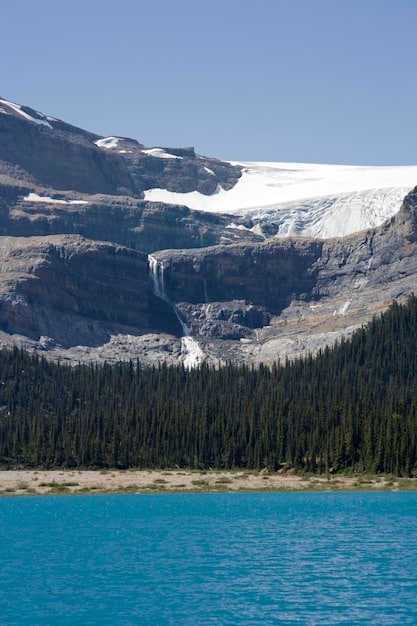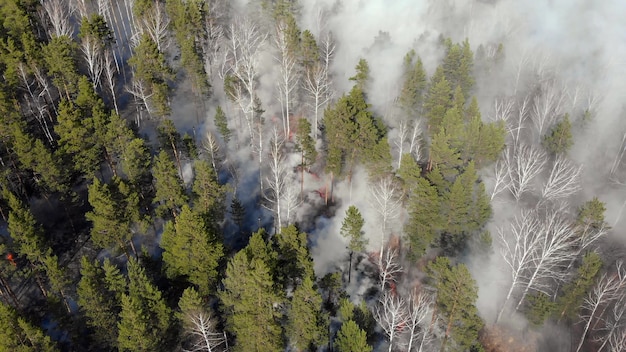Climate Change and US National Parks: Impacts and Adaptations

Climate change profoundly impacts US national parks and protected areas, leading to rising temperatures, altered precipitation patterns, increased wildfires, and threats to biodiversity, necessitating adaptive management strategies to preserve these natural treasures.
How will climate change impact US national parks and protected areas? The answer is complex and alarming. From the towering peaks of the Rocky Mountains to the delicate ecosystems of the Everglades, America’s natural wonders face unprecedented challenges.
Understanding the Broad Impacts of Climate Change on US National Parks
Climate change is no longer a distant threat; it is a present reality reshaping the landscapes of US national parks. The consequences range from subtle shifts in plant life to dramatic alterations of iconic landmarks.
These changes affect not only the natural environment but also the cultural and recreational values that these parks hold.
Rising Temperatures and Shifting Ecosystems
One of the most direct impacts of climate change is the increase in average temperatures, which affects the delicate balance of ecosystems within national parks.
As temperatures rise, plant and animal species struggle to adapt, leading to shifts in their distribution and potential extinctions.
- Changes in Vegetation Zones: Warmer temperatures enable certain plant species to move to higher elevations, displacing native alpine vegetation.
- Impacts on Wildlife: Animals adapted to colder climates, like the pika, face habitat loss and increased stress.
- Increased Pest Infestations: Warmer winters allow pests like bark beetles to thrive, devastating forests.

The interplay between rising temperatures, shifting ecosystems, and increased pest infestations creates a cascade of challenges for park managers.
Addressing these impacts requires a multifaceted approach that considers both large-scale climate trends and localized ecological factors.
The Effects on Water Resources and Hydrology
Water is the lifeblood of any ecosystem, and climate change is significantly altering water resources within US national parks. Changes in precipitation patterns, snowmelt dynamics, and evaporation rates all contribute to complex challenges.
These hydrological shifts affect everything from stream flows to lake levels and groundwater availability.
Altered Precipitation Patterns
Changes in precipitation patterns lead to both increased drought and intense flooding, disrupting ecosystems and infrastructure.
Some regions experience prolonged dry spells, while others face more frequent and severe storms.
- Drought Conditions: Reduced rainfall leads to water stress for plants and animals, exacerbating wildfire risk.
- Increased Flooding: Heavy rainfall events cause erosion, damage infrastructure, and alter aquatic habitats.
- Changes in Snowpack: Warmer temperatures reduce snowpack, affecting water availability in downstream areas.
Hydrological changes are interconnected with other climate change impacts, amplifying risks to park ecosystems.
Effective water management strategies are essential for mitigating negative effects and ensuring the long-term health of these valuable ecosystems.
The Growing Threat of Wildfires
Wildfires are a natural part of many ecosystems, but climate change is intensifying wildfire seasons, posing significant threats to US national parks. Warmer temperatures, drier conditions, and increased fuel loads all contribute to heightened fire risk.
These intense wildfires can devastate landscapes and disrupt ecological processes.
Increased Frequency and Intensity of Wildfires
Climate change is lengthening wildfire seasons and causing fires to burn more intensely, making them harder to control.
The interplay of climate factors and vegetation conditions creates a challenging environment for wildfire management.
- Extended Fire Seasons: Warmer temperatures and drier conditions prolong the period when wildfires can easily ignite and spread.
- Increased Fuel Loads: Accumulation of dry vegetation increases the intensity of wildfires.
- Extreme Fire Behavior: Climate change contributes to extreme fire behavior, such as rapid spread and unpredictable changes in direction.

Managing wildfires requires integrating ecological knowledge, advanced technology, and collaboration among various stakeholders.
Protecting parks from wildfires is an ongoing challenge that requires adaptive strategies and sustained investment.
Impacts on Coastal Parks and Sea Level Rise
Coastal national parks face unique challenges from climate change, particularly the rise in sea levels. Rising sea levels erode shorelines, inundate coastal wetlands, and threaten infrastructure.
These changes have far-reaching consequences for both natural and cultural resources.
Sea Level Rise and Coastal Erosion
Sea level rise is causing the gradual loss of coastal habitats, which are critical for numerous plant and animal species.
Erosion undermines infrastructure and threatens cultural sites located along coastlines.
- Loss of Wetlands: Saltwater intrusion destroys freshwater wetlands, reducing their capacity to support biodiversity.
- Erosion of Shorelines: Increasing wave action and storm surges erode beaches and bluffs, altering the landscape.
- Threats to Infrastructure: Roads, buildings, and other park infrastructure face damage from rising sea levels and coastal flooding.
Addressing these impacts requires innovative strategies, such as restoring protective coastal habitats and fortifying infrastructure.
Protecting coastal parks from sea level rise is essential for preserving their ecological and cultural heritage.
The Effects on Park Visitation and Recreation
Climate change also impacts park visitation and recreational opportunities. Altered landscapes, changing weather patterns, and increased hazards affect visitor experiences.
These changes require park managers to adapt recreational offerings and ensure visitor safety.
Changing Recreational Opportunities
Climate change can alter the types of recreational activities that are available in national parks.
For example, reduced snowpack shortens the ski season, while increased flooding closes hiking trails.
- Loss of Winter Recreation: Reduced snowpack diminishes opportunities for skiing, snowboarding, and snowshoeing.
- Impacts on Water-Based Recreation: Changes in stream flows and lake levels affect boating, fishing, and swimming.
- Increased Hazards: Wildfires, landslides, and extreme weather events increase risks to visitors.
Adapting to changing recreational opportunities requires creating new activities, managing risks, and educating visitors.
Ensuring a safe and enjoyable experience for park visitors is vital for maintaining public support for conservation efforts.
Strategies for Adaptation and Resilience
Despite the challenges, there are numerous strategies for enhancing the resilience of US national parks in the face of climate change. Adaptive management, restoration efforts, and collaborative partnerships are key.
These approaches aim to reduce vulnerability and enhance the long-term health of park ecosystems.
Adaptive Management and Restoration Efforts
Adaptive management involves continuously monitoring environmental conditions and adjusting management strategies based on observed changes.
Restoration efforts focus on repairing damaged ecosystems and promoting biodiversity.
- Ecosystem Monitoring: Tracking changes in temperature, precipitation, vegetation, and wildlife populations informs management decisions.
- Habitat Restoration: Planting native vegetation, removing invasive species, and restoring hydrological processes enhance ecosystem health.
- Building Resilience: Promoting biodiversity and maintaining ecosystem integrity increases the ability of parks to withstand climate change impacts.
Collaboration among scientists, managers, and stakeholders is crucial for effective adaptation and resilience efforts.
Protecting US national parks from climate change requires a long-term commitment to adaptive management and ecosystem stewardship.
| Key Point | Brief Description |
|---|---|
| 🌡️ Rising Temperatures | Ecosystem shifts, habitat loss, and increased pest infestations. |
| 💧 Water Resource Changes | Altered precipitation patterns, leading to droughts and floods. |
| 🔥 Increased Wildfires | Longer fire seasons and more intense wildfires. |
| 🌊 Sea Level Rise | Coastal erosion and loss of wetlands, threatening infrastructure. |
Frequently Asked Questions
▼
Rising temperatures cause habitat loss for cold-adapted species like the pika, disrupt migration patterns, and increase stress, making them more vulnerable to disease and predation.
▼
Altered precipitation leads to both increased drought and intense flooding, disrupting water availability for plants and animals, increasing wildfire risk, and damaging infrastructure.
▼
Warmer temperatures, drier conditions, and increased fuel loads due to climate change contribute to longer fire seasons, more intense fires, and extreme fire behavior, making them harder to control.
▼
Sea level rise causes coastal erosion, inundates wetlands, and threatens infrastructure in coastal national parks, leading to habitat loss and damage to historical and cultural sites.
▼
Adaptation strategies include ecosystem monitoring, habitat restoration, adaptive management, and collaborative partnerships aimed at improving the resilience of parks to climate change impacts.
Conclusion
Climate change poses a serious threat to US national parks and protected areas, but by understanding the impacts and implementing adaptive strategies, we can help preserve these natural treasures for future generations. The coordinated efforts of scientists, park managers, and the public are essential to mitigate the damage and ensure these landscapes continue to inspire and provide invaluable ecological services.





